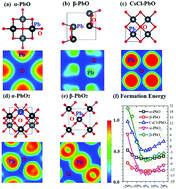Mechanical and optical behaviors: strain synergy effects in high temperature phase oxides of lead†
Abstract
Since lead has a very high absorption coefficient (μ), the radiations from within the bulk material do not penetrate the layers. While oxygen and water (O2 and H2O) in the environment react with lead forming the oxide of lead, the radiation protection performance will be degradation. In this study, density functional theory was used to study the mechanical and dielectric properties of lead oxides (α-PbO, β-PbO, CsCl–PbO, α-PbO2, and β-PbO2). Young's modulus, bulk modulus and shear modulus, Poisson's ratio and many other parameters under strain in the range of −20% to +20% were calculated. Particularly for lead oxides, the Pb 6s lone-pair electron states were also discussed, and their influence on the mechanical and dielectric properties was unveiled in detail. Surprisingly, it was found that the electric dipoles formed by lone-pair lobes contributed only slightly to the strain synergy effect, whereas the concomitant ionic displacements and lattice distortions were prominently favorable for mechanical and optical behaviors. Indeed, it was found that the strain synergy effects played an important role in the mechanical and optical behaviors of lead oxides, especially apparent for β-PbO. This study provides a simple yet straightforward way to demonstrate the mechanisms of strain synergy effects in the high temperature phase oxide of lead, which can be applied to the study of the same mechanism in other relevant materials.



 Please wait while we load your content...
Please wait while we load your content...